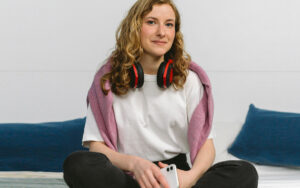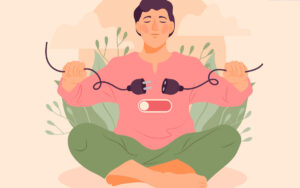Social anxiety has become increasingly common in our modern, hyper-connected world. At Gloow.care, we believe in a holistic approach that integrates ancient self-healing techniques with modern awareness of how to care for both mind and body. Here are 10 holistic tips to help you navigate the challenges of social anxiety while nurturing your overall well-being.
What is Social Anxiety and Why is It So Common Today?
Social anxiety is characterized by an intense fear of being judged, embarrassed, or rejected in social situations. With the rise of social media and the constant exposure to others’ lives, this fear has only grown. Today, social anxiety isn’t just about face-to-face interactions but also extends to how we present ourselves online. The pressure to perform, be perfect, and meet expectations—whether at work, in social events, or even online—exacerbates these feelings.
Common triggers for social anxiety in today’s world include:
- Work meetings where speaking in front of colleagues induces fear of judgment.
- Social events, like parties or gatherings, where interacting with large groups can feel overwhelming.
- Dating, where the fear of rejection or embarrassment is heightened.
Key Benefits
- Immediate stress reduction through natural practices like aromatherapy and mindful breathing.
- Boosted self-confidence through mental and physical preparation for social situations.
- Better social interactions by integrating calming techniques into daily routines.
- Emotional balance through a holistic approach that blends ancient wisdom with modern practices.
1. Start Your Day with a Calming Routine
To set a peaceful tone for your day, incorporate aromatherapy into your morning. Essential oils like lavender or chamomile can soothe your nervous system and reduce anxiety before stepping into social situations. Apply a few drops to your wrists or diffuse them in your space to create a calming atmosphere.
2. Prepare Your Outfit the Night Before
Choosing your outfit in advance helps reduce the stress of rushing in the morning. Opt for comfortable, natural fabrics that make you feel good, as physical comfort can directly impact your mental state. This small step can make a big difference in how you face the day.

3. Practice Conscious Breathing on Your Way to Work
If you’re heading into a potentially stressful situation, such as a meeting or a social event, take a moment to practice deep breathing. Inhale for four seconds, hold for four, and exhale for four. This will help slow your heart rate and calm your mind.
4. Create a Calming Workspace
Your physical environment can significantly impact your mental state. Bring elements into your workspace that make you feel at ease—whether it’s a plant, a calming photo, or a small diffuser for essential oils. A peaceful environment helps reduce anxiety triggers throughout the day.
5. Write Down Key Points Before a Meeting
Before stepping into a work meeting or presentation, jot down a few key points you want to cover. This allows you to feel more prepared and in control, reducing the anxiety that comes from being put on the spot. To enhance this feeling of calm, pair your preparation with a soothing ritual, such as drinking a herbal tea.
Consider sipping chamomile tea, known for its gentle sedative properties, to relax your nerves. Alternatively, lemon balm tea can help reduce stress and sharpen your focus. For a more grounding effect, try lavender tea, which soothes the nervous system and promotes clarity. If you need something more robust for calming anxiety, passionflower tea is a perfect choice, as it helps increase GABA production, reducing nervous tension.
Incorporating these teas into your pre-meeting routine will help you not only stay organized but also reduce anxiety on both a mental and physical level, giving you the confidence to tackle the meeting calmly.

6. Limit Social Media Use
Social media can heighten anxiety, especially when it encourages constant comparison with others. Set boundaries for how much time you spend on social platforms, and consider taking regular digital detoxes. Disconnecting from the virtual world can give your mind space to relax and reset.
7. Choose Comfortable Locations for Social Meetups
If you have a social event or date, pick a venue where you feel relaxed, such as a quiet café or a park. Avoid crowded, noisy places that may increase your anxiety. Choosing a calming environment makes it easier to stay present and comfortable during social interactions.
8. Practice Visualization Techniques
Visualization is a powerful mental tool that can help shift your mindset from anxiety to confidence before entering a stressful social encounter. This practice involves mentally rehearsing a situation, allowing you to picture yourself succeeding, which reduces anxiety and promotes a sense of control. Even if you’re new to visualization, it’s an accessible technique that anyone can master with practice.
How to Get Started with Visualization:
1. Find a Quiet Space:
Before the social event or meeting, take 5 to 10 minutes to find a quiet place where you won’t be disturbed. This could be at home, in your car, or even a bathroom stall if you’re already at the event. Close your eyes and sit or stand comfortably, allowing your mind to settle.
2. Deep Breathing:
Start with deep, conscious breathing to calm your nervous system. Inhale deeply through your nose for four seconds, hold the breath for four seconds, and exhale slowly through your mouth for another four seconds. This helps reduce physical tension and prepares your mind for visualization.
3. Create a Mental Image:
Visualize the upcoming social situation in as much detail as possible. Imagine the setting: the room, the people, the sounds, and even how you’re dressed. The more vividly you can recreate the environment, the better. For example, if you’re about to attend a meeting, picture yourself confidently entering the room, greeting colleagues, and engaging in the conversation smoothly.
4. Focus on Positive Outcomes:
Picture yourself handling the situation with ease. Imagine yourself speaking confidently, maintaining eye contact, and receiving positive reactions from others. Envision how it feels to be calm and in control. By focusing on these positive outcomes, your brain begins to associate the upcoming event with success, rather than fear.
5. Use All Your Senses:
Incorporate all your senses into the visualization. Feel the warmth or coolness of the room, hear the sounds of people chatting, and notice how your body feels—relaxed, confident, and comfortable. Engaging multiple senses helps make the visualization more realistic and impactful.
6. Positive Affirmations:
While visualizing, use positive affirmations like “I am calm and confident,” “I am in control of my emotions,” or “I communicate clearly and effectively.” Repeating these phrases reinforces the positive image you’re creating in your mind and can build confidence.
7. End with Gratitude:
Once you’ve completed your visualization, take a moment to express gratitude for the opportunity to challenge yourself and grow. This helps create a positive mental association with the situation, reinforcing the idea that social interactions are something you can master, not fear.
Why Visualization Works:
Visualization is effective because the brain often doesn’t differentiate between real and imagined experiences. By mentally rehearsing a successful interaction, you’re training your brain to respond more calmly and confidently in the real situation. This technique is used by athletes, public speakers, and even executives to prepare for high-pressure scenarios.

9. Use Anchoring Techniques at Social Events
When you find yourself feeling overwhelmed in social settings, use grounding techniques to stay present. Hold a small, familiar object like a bracelet or a smooth stone in your hand to help center yourself. This physical anchor can provide comfort and help keep your mind focused.
10. Give Yourself Permission to Leave
Remember, you’re never obligated to stay in a situation that feels overwhelming. Give yourself permission to step outside or leave early if necessary. Setting these boundaries for yourself is an essential form of self-care and will help you feel more in control of your anxiety.
In today’s fast-paced, digitally connected world, social anxiety can feel overwhelming, but it doesn’t have to control your life. With a holistic approach that combines ancient healing practices with modern self-care, you can navigate social situations with greater ease. At Gloow.care, we believe in nurturing the whole self, mind and body, to create lasting emotional balance.



































